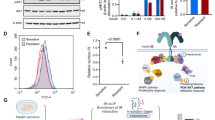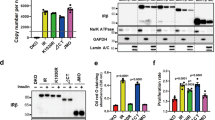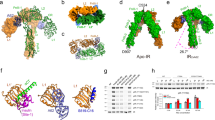Abstract
Aim:
Activating transcription factor 6 (ATF6) is a key signal transducer of endoplasmic reticulum stress (ER stress). This study was conducted to clarify the potential role of ATF6 in the insulin signaling pathway under chronic ER stress.
Methods:
ER stress of HEK293 cells was induced with tunicamycin (2 μg/mL). The cells were transfected with ATF6α or ATF6β. The phosphorylation level of insulin receptor (IR) was analyzed using Western blot. The changes in ER stress and ERK signaling pathways were explored using Western blot and quantitative real-time PCR.
Results:
Tunicamycin-induced chronic ER stress attenuated IR tyrosine phosphorylation in a time-dependent manner, whereas over-expression of ATF6 protected IR from desensitization. ATF6 modulation of IR suppression was associated with insulin-stimulated extracellular signal-regulated kinase (ERK) phosphorylation. The treatment of the cells with a specific ERK inhibitor U0126 (10 μmol/L) mimicked the effect of ATF6 over-expression and restored the insulin-stimulated IR phosphorylation. The treatment of the cells with the ERK activator epidermal growth factor (EGF, 200 ng/mL) decreased the protection effect of ATF6 on IR.
Conclusion:
Our results demonstrate that ATF6 may serve as a potential therapeutic target for the treatment of insulin resistance and type 2 diabetes.
Similar content being viewed by others
Log in or create a free account to read this content
Gain free access to this article, as well as selected content from this journal and more on nature.com
or
References
Saltiel AR, Kahn CR . Insulin signalling and the regulation of glucose and lipid metabolism. Nature 2001; 414: 799–806.
Kaufman RJ . Stress signaling from the lumen of the endoplasmic reticulum: coordination of gene transcriptional and translational controls. Genes Dev 1999; 13: 1211–33.
Ozcan U, Cao Q, Yilmaz E, Lee AH, Iwakoshi NN, Ozdelen E, et al. Endoplasmic reticulum stress links obesity, insulin action, and type 2 diabetes. Science 2004; 306: 457–61.
Ozcan U, Yilmaz E, Ozcan L, Furuhashi M, Vaillancourt E, Smith RO, et al. Chemical chaperones reduce ER stress and restore glucose homeostasis in a mouse model of type 2 diabetes. Science 2006; 313: 1137–40.
Ozawa K, Miyazaki M, Matsuhisa M, Takano K, Nakatani Y, Hatazaki M, et al. The endoplasmic reticulum chaperone improves insulin resistance in type 2 diabetes. Diabetes 2005; 54: 657–63.
Nakatani Y, Kaneto H, Kawamori D, Yoshiuchi K, Hatazaki M, Matsuoka TA, et al. Involvement of endoplasmic reticulum stress in insulin resistance and diabetes. J Biol Chem 2005; 280: 847–51.
Gao Z, Zhang X, Zuberi A, Hwang D, Quon MJ, Lefevre M, et al. Inhibition of insulin sensitivity by free fatty acids requires activation of multiple serine kinases in 3T3-L1 adipocytes. Mol Endocrinol 2004; 18: 2024–34.
Herschkovitz A, Liu YF, Ilan E, Ronen D, Boura-Halfon S, Zick Y . Common inhibitory serine sites phosphorylated by IRS-1 kinases, triggered by insulin and inducers of insulin resistance. J Biol Chem 2007; 282: 18018–27.
Ye J, Rawson RB, Komuro R, Chen X, Davé UP, Prywes R, et al. ER stress induces cleavage of membrane-bound ATF6 by the same proteases that process SREBPs. Mol Cell 2000; 6: 1355–64.
Shen J, Chen X, Hendershot L, Prywes R . ER stressregulation of ATF6 localization by dissociation of BiP/GRP78 binding and unmasking of Golgi localization signals. Dev Cell 2002; 3: 99–111.
Thuerauf DJ, Morrison LE, Hoover H, Glembotski CC . Coordination of ATF6–mediated transcription and ATF6 degradation by a domain that is shared with the viral transcription factor, VP16. J Biol Chem 2002; 277: 20734–9.
Thuerauf DJ, Morrison L, Glembotski C . Opposing roles for ATF6alpha and ATF6beta in endoplasmic reticulum stress response gene induction. J Biol Chem 2004; 279: 21078–84.
Thuerauf DJ, Marcinko M, Belmont PJ, Glembotski CC . Effects of the isoform-specific characteristics of ATF6 alpha and ATF6 beta on endoplasmic reticulum stress response gene expression and cell viability. J Biol Chem 2007; 282: 22865–78.
Salminen A, Kauppinen A, Suuronen T, Kaamiranta K, Ojala J . ER stress in Alzheimer's disease: a novel neuronal trigger for inflammation and Alzheimer's pathology. J Neuroinflammation 2009; 6: 41.
Kapoor A, Sanyal AJ . Endoplasmic reticulum stress and the unfolded protein response. Clin Liver Dis 2009; 13: 581–90.
Dobson CM . Principles of protein folding, misfolding and aggregation. Semin Cell Dev Biol 2004; 15: 3–16.
Kammoun HL, Hainault I, Ferré P, Foufelle F . Nutritional related liver disease: targeting the endoplasmic reticulum stress. Curr Opin Clin Nutr Metab Care 2009; 12: 575–82.
Fonseca SG, Burcin M, Gromada J, Urano F . Endoplasmin reticulum stress in beta-cells and development of diabetes. Curr Opin Pharmacol 2009; 9: 763–70.
Scheuner D, Kaufman RJ . The unfolded protein response: a pathway that links insulin demand with beta-cell failure and diabetes. Endocr Rev 2008; 29: 317–33.
Izawa Y, Yoshizumi M, Fujita Y, Ali N, Kanematsu Y, Ishizawa K, et al. ERK1/2 activation by angiotensin II inhibits insulin-induced glucose uptake in vascular smooth muscle cells. Exp Cell Res 2005; 308: 291–9.
Yoshida H, Okada T, Haze K, Yanagi H, Yura T, Negishi M, et al. ATF6 activated by proteolysis binds in the presence of NF-Y (CBF) directly to the cis-acting element responsible for the mammalian unfolded protein response. Mol Cell Biol 2000; 20: 6755–67.
Morris JA, Dorner AJ, Edwards CA, Hendershot LM, Kaufman RJ . Immunoglobulin binding protein (BiP) function is required to protect cells from endoplasmic reticulum stress but is not required for the secretion of selective proteins. J Biol Chem 1997; 272: 4327–34.
Wu J, Rutkowski DT, Dubois M, Swathirajan J, Saunders T, Wang J, et al. ATF6alpha optimizes long-term endoplasmic reticulum function to protect cells from chronic stress. Dev Cell 2007; 13: 351–64.
Yamamoto K, Sato T, Matsui T, Sato M, Okada T, Yoshida H, et al. Transcriptional induction of mammalian ER quality control proteins is mediated by single or combined action of ATF6alpha and XBP1. Dev Cell 2007; 13: 365–76.
Yoshida H, Haze K, Yanagi H, Yura T, Mori K . Identification of the cis-acting endoplasmic reticulum stress response element responsible for transcriptional induction of mammalian glucose-regulated proteins. Involvement of basic leucine zipper transcription factors. J Biol Chem 1998; 273: 33741–9.
Haze K, Yoshida H, Yanagi H, Yura T, Mori K . Mammalian transcription factor ATF6 is synthesized as a transmembrane protein and activated by proteolysis in response to endoplasmic reticulum stress. Mol Biol Cell 1999; 10: 3787–99.
Ni M, Lee AS . ER chaperones in mammalian development and human diseases. FEBS Lett 2007; 581: 3641–51.
Ji C, Kaplowitz N . ER stress: Can the liver cope? J Hepatol 2006; 45: 321–33.
Nakayaa H, Zhao J, Ei-Fakhrany A, Isosaki M, Satoh H, Kyotani Y, et al. Neuroprotective effects of praipexole against tunicaycin-induced cell death in PC12 cells. Clin Exp Pharacol Physiol 2009; 36: 1183–5.
Urano F, Wang X, Bertolotti A, Zhang Y, Chung P, Harding HP, et al. Coupling of stress in the ER to activation of JNK protein kinases by transmembrane protein kinase IRE1. Science 2000; 287: 664–6.
Hirosumi J, Tuncman G, Chang L, Görgün CZ, Uysal KT, Maeda K, et al. A central role for JNK in obesity and insulin resistance. Nature 2002; 420: 333–6.
Aguirre V, Uchida T, Yenush L, Davis R, White MF . The c-Jun NH2-terminal kinase promotes insulin resistance during association with insulin receptor substrate-1 and phosphorylation of Ser(307). J Biol Chem 2000; 275: 9047–54.
Fujishiro M, Gotoh Y, Katagiri H, Sakoda H, Ogihara T, Anai M, et al. Three mitogen-activated protein kinases inhibit insulin signaling by different mechanisms in 3T3-L1 adipocytes. Mol Endocrinol 2003; 17: 487–97.
De Fea K, Roth RA . Modulation of insulin receptor substrate-1 tyrosine phosphorylation and function by mitogen-activated protein kinase. J Biol Chem 1997; 272: 31400–6.
Engelman JA, Berg AH, Lewis RY, Lisanti MP, Scherer PE . Tumor necrosis factor alpha-mediated insulin resistance, but not dedifferentiation, is abrogated by MEK1/2 inhibitors in 3T3-L1 adipocytes. Mol Endocrinol 2000; 14: 1557–69.
Sweeney G, Somwar R, Ramlal T, Volchuk A, Ueyama A, Klip A . An inhibitor of p38 mitogen-activated protein kinase prevents insulin-stimulated glucose transport but not glucose transporter translocation in 3T3-L1 adipocytes and L6 myotubes. J Biol Chem 1999; 274: 10071–8.
Somwar R, Kim DY, Sweeney G, Huang C, Niu W, Lador C, et al. GLUT4 translocation precedes the stimulation of glucose uptake by insulin in muscle cells: potential activation of GLUT4 via p38 mitogen-activated protein kinase. Biochem J 2001; 359: 639–49.
Hotamisligil GS . Inflammation and endoplasmic reticulum stress in obesity and diabetes. Int J Obes (Lond) 2008; 32: S52–4.
Hotamisligil GS . Endoplasmic reticulum stress and the inflammatory basis of metabolic disease. Cell 2010; 140: 900–17.
Wu RF, Terada LS . Focal oxidant and Ras signaling on the ER surface activates autophagy. Autophagy 2010; 6: 828–9.
Hotamisligil G . Role of endoplasmic reticulum stress and c-Jun NH2-terminal kinase pathways in inflammation and origin of obesity and diabetes. Diabetes 2005; 54: S73–8.
Hotamisligil GS, Shargill NS, Spiegelman BM . Adipose expression of tumor necrosis factor-alpha: direct role in obesity-linked insulin resistance. Science 1993; 259: 87–91.
Srinivasan S, Ohsugi M, Liu Z, Fatrai S, Bernal-Mizrachi E, Permutt MA . Endoplasmic reticulum stress-induced apoptosis is partly mediated by reduced insulin signaling through phosphatidylinositol 3-kinase/Akt and increased glycogen synthase kinase-3beta in mouse insulinoma cells. Diabetes 2005; 54: 968–75.
Lee K, Tirasophon W, Shen X, Michalak M, Prywes R, Okada T, et al. IRE1-mediated unconventional mRNA splicing and S2P-mediated ATF6 cleavage merge to regulate XBP1 in signaling the unfolded protein response. Genes Dev 2002; 16: 452–66.
Thameem F, Farook VS, Bogardus C, Prochazka M . Association of amino acid variants in the activating transcription factor 6 gene (ATF6) on 1q21-q23 with type 2 diabetes in Pima Indians. Diabetes 2006; 55: 839–42.
Hu P, Han Z, Couvillon AD, Exton JH . Critical role of endogenous Akt/IAPs and MEK1/ERK pathways in counteracting endoplasmic reticulum stress-induced cell death. J Biol Chem 2004; 279: 49420–9.
Nishitoh H, Matsuzawa A, Tobiume K, Saegusa K, Takeda K, Inoue K, et al. ASK1 is essential for endoplasmic reticulum stress–induced neuronal cell death triggered by expanded polyglutamine repeats. Genes Dev 2002; 16: 1345–55.
Zeng L, Lu M, Mori K, Luo S, Lee AS, Zhu Y, et al. ATF6 modulates SREBP2-mediated lipogenesis. EMBO J 2004; 23: 950–8.
Seo HY, Kim YD, Lee KM, Min AK, Kim MK, Kim HS, et al. Endoplasmic reticulum stress-induced activation of activating transcription factor 6 decreases insulin gene expression via up-regulation of orphan nuclear receptor small heterodimer partner. Endocrinology 2008; 149: 3832–41.
Acknowledgements
We gratefully acknowledge Prof Kazutoshi MORI for the plasmids of pcDNA3.1-hATF6α and pcDNA3.1-hATF6β. This work was supported by the State Key Program of Basic Research of China (No 2010CB912501 and 2007CB914304), the National Natural Science Foundation of China (No 90713046 and 30890044), Shanghai Basic Research Project from the Shanghai Science and Technology Commission (No 11ZR1444500) and Open Research Fund of the Key Laboratory of Biotherapy, West China Hospital, West China Medicine School, Sichuan University (No SKLB200901).
Author information
Authors and Affiliations
Corresponding author
Additional information
Supplementary figures are available at Acta Pharmacologica Sinica website of NPG.
Supplementary information
Supplementary Figure 1
GRP78 protein level responded to tunicamycin stimulation more potentially in ATF6 over-expression stable cells than in control cells. (DOC 70 kb)
Supplementary Figure 2
ATF6 protected AKT phosphorylation from desensitization induced by tunicamycin incubation. (DOC 137 kb)
Rights and permissions
About this article
Cite this article
Tang, X., Shen, H., Chen, J. et al. Activating transcription factor 6 protects insulin receptor from ER stress-stimulated desensitization via p42/44 ERK pathway. Acta Pharmacol Sin 32, 1138–1147 (2011). https://doi.org/10.1038/aps.2011.75
Received:
Accepted:
Published:
Issue date:
DOI: https://doi.org/10.1038/aps.2011.75
Keywords
This article is cited by
-
FX5, a non-steroidal glucocorticoid receptor antagonist, ameliorates diabetic cognitive impairment in mice
Acta Pharmacologica Sinica (2022)
-
SP6616 as a new Kv2.1 channel inhibitor efficiently promotes β-cell survival involving both PKC/Erk1/2 and CaM/PI3K/Akt signaling pathways
Cell Death & Disease (2016)



